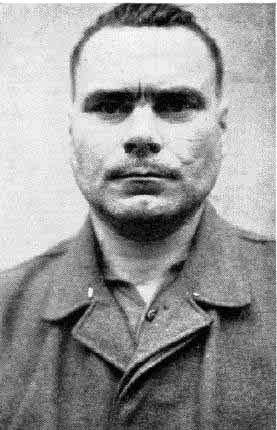Josef Kramer (Josef Kramer)

Josef Kramer joined the Nazi Party in 1931 and the SS in 1932. His SS training led him into work as a prison guard and, after the outbreak of war, as a concentration camp guard. In 1934, he was assigned as a guard at Dachau. His promotion was rapid, obtaining senior posts at Sachsenhausen and Mauthausen concentration camps. He became assistant to Rudolf Höß, the Commandant at Auschwitz in 1940. He accompanied Rudolf Höß to inspect Auschwitz as a possible site for a new synthetic oil and rubber plant, which was a vital industry in Germany given its shortage of oil. Kramer was named Commandant of Natzweiler-Struthof concentration camp in April 1941. Natzweiler-Struthof was the only concentration camp established by the Nazis on present-day French territory, though there were French-run transit camps such as the one at Drancy. At the time, the Alsace-Lorraine area in which it was established had been annexed by Nazi Germany.
As commandant at Natzweiler-Struthof, Josef Kramer personally carried out the gassings of 80 Jewish men and women, part of a group of 87 selected at Auschwitz to become anatomical specimens in a proposed Jewish skeleton collection to be housed at the Anatomy Institute at the Reich University of Strasbourg under the direction of August Hirt. Ultimately 87 of the inmates were shipped to Natzweiler-Struthof, 46 of these individuals were originally from Thessaloniki, Greece. The deaths of 86 of these inmates were, in the words of Hirt, “induced” in an improvised gassing facility at Natzweiler-Struthof and their corpses, 57 men and 29 women, were sent to Strasbourg. One male victim was shot as he fought to keep from being gassed. Josef Kramer, acting commandant of Natzweiler-Struthof (who would become the commandant at Auschwitz and the last commandant of Bergen Belsen) personally carried out the gassing of 80 of these 86 victims. The first part of the process for this “collection” was to make anatomical casts of the bodies prior to reducing them to skeletons. In 1944, with the approach of the allies, there was concern over the possibility that the corpses, which had still not been defleshed, could be discovered. In September 1944 Wolfram Sievers telegrammed Rudolf Brandt: “The collection can be defleshed and rendered unrecognizable. This, however, would mean that the whole work had been done for nothing-at least in part-and that this singular collection would be lost to science, since it would be impossible to make plaster casts afterwards.”
Josef Kramer was promoted to the rank of Hauptsturmführer (Captain) in 1942 and in May 1944 was transferred to become the Lagerführer, in charge of operations at Auschwitz II-Birkenau, the main killing center within the Auschwitz concentration camp complex, from 8 May 1944 to 25 November 1944. He was brought to Auschwitz to manage the gassings of new transports in May 1944, according to the Prosecution Judge Advocate at the War Crimes tribunal which convicted him of being responsible for the murders committed at Auschwitz. There were a number of witnesses who said that he took an active part in the selection parades, in that for instance he loaded people into the trucks and beat them when they would not get into the trucks. At Auschwitz, Kramer soon became notorious among his subordinates as a harsh taskmaster. One of the defendants at the Frankfurt Auschwitz Trial, Dr. Franz Lucas, testified that he tried to avoid assignments given him by Kramer by pleading stomach and intestinal disorders. When Dr. Lucas saw that his name had been added to the list of selecting physicians for a large group of inmates transferred from Hungary, he objected strenuously. Kramer reacted sharply: “I know you are being investigated for favouring prisoners. I am now ordering you to go to the ramp, and if you fail to obey an order, I shall have you arrested on the spot”.
In December 1944, Josef Kramer was transferred from Birkenau to Bergen Belsen, near the village of Bergen. Belsen had originally served as a temporary camp for those leaving Germany, but during the war had been expanded to serve as a convalescent depot for the ill and displaced people from across north-west Europe. Although it had no gas chambers, Kramer’s rule was so harsh that he became known as the “Beast of Belsen”. As Germany collapsed, administration of the camp broke down, but Kramer remained devoted to bureaucracy. On 1 March 1945, he filed a report asking for help and resources, stating that of the 42,000 inmates in his camp, 250–300 died each day from typhus. On 19 March, the number of inmates rose to 60,000 as the Germans continued to evacuate camps that were soon to be liberated by the Allies. As late as the week of 13 April, some 28,000 additional prisoners were brought in. With the collapse of administration and many guards fleeing to escape retribution, roll calls were stopped, and the inmates were left to their own devices. Corpses rotted everywhere, and rats attacked the living too weak to fight them off. Kramer remained even when the British arrived to liberate the camp, and took them on a tour of the camp to inspect the “scenes”. Piles of corpses lay all over the camp, mass graves were filled in, and the huts were filled with prisoners in every stage of emaciation and disease.
Josef Kramer was imprisoned at the Hamelin jail. Along with 44 other camp staff Kramer was tried in the Belsen Trial by a British military court at Lüneburg. The trial lasted several weeks from September to November 1945. During the trial Anita Lasker testified that Kramer took part in selections for the gas chamber. Kramer was sentenced to death on 17 November 1945, and hanged at Hamelin jail by Albert Pierrepoint on 13 December 1945.
Born
- November, 10, 1906
- Munich, Germany
Died
- December, 13, 1945
- Hamelin, Germany
Cause of Death
- execution by hanging
Cemetery
- Am Wehl
- Hanover, Lower Saxony
- Germany



